Keywords: architectural media, LED screen, high transparency, glass curtain wall
Abstract: We often call the buildings "architectural media" which are referred to carriers of information. With the development of photoelectric technology like LED, architectural media technology has made saltant progress. In recent years it has been gradually chased after by the market, especially in the application of glass curtain wall building, where various solutions have emerged. A new type of LED display technology of high transparency, which is featured as high permeability and ultrathin, has obvious advantages in the field of architectural media.
A. Technical Background
High buildings in metropolises are very ideal fro outdoor advertising carriers. People trying to make the whole building a three-dimensional photoelectric advertising carrier through various technical means such as LED, laser, projection, which is known as "architectural media" technology, became popular in Europe and the United States in recent years. At the same time, we also recognize that glass curtain wall structure accounts for the vast majority of modern buildings in metropolises, especially those newly-built buildings. It is currently a very popular technology subject how to turn the glass curtain wall buildings into "architectural media" and give play to its commercial value. It needs to solve the following technical problems: (1) avoiding destroying the appearance and structure of glass curtain wall;(2) keeping the permeability of glass curtain wall;(3) making the expressive force of building media strongest.
B. Existing technologies
In order to solve the contradiction mentioned above, a variety of solutions have emerged in the market.
1. LED pixel lights, guardrail tubes
LED pixel lights and guardrail tubes are the most commonly used technologies in building lighting, which often are installed on the outline of buildings or seams of glass curtain walls. This method is of low cost, convenient installation, simple control, but at the same time the display effect is very limited. Even if the external facades of the entire building are covered, it can only display simple patterns and text messages, which is far from the desired effect of performance.
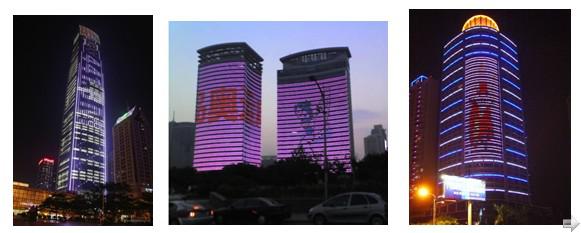
2. Box-type LED screens
Box-type LED screens are installed in the external walls of buildings, of which the image resolution is high and the visual effect is fairly clear. But the weight of the box type structure is very large (40-70 kg / m2), and it requires additional design of steel structure for installing. The cost is high, and the load to external walls is big, meanwhile it is not pervious for lights, which has led to the loss of daylighting function of the wall. When the LED screens don’t work, they are just like a dark wall, which extremely affects the appearance of the buildings.

3. Grid-type LED screens
Grid-type LED screens have certain permeability, which guarantees approximately 40% of the daylighting transparent effect of the glass curtain wall, at the same time, it can be installed in a large area. The shortcoming lies in its low resolution, because the pixel spacing is generally over 40 mm, and some 60 mm - 100 mm, so that a certain permeability rate can be ensured, and the screen can't get a clear display effect of images. At the same time, the outdoor large-scale installation calls for a high standard of construction and maintenance, and it is expensive, so the bearing of the screen and the problems of installation and maintenance need to be considered in the design of the building.
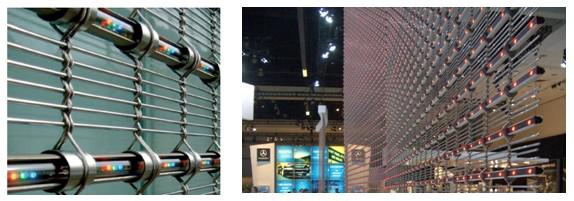
4. The projection
The technology of projecting images to building walls by a projector has also been applied, but it is well known that the lumen degree of current projectors is relatively low, and the light bulbs’ lifetime is short, the price expensive, at the same time the projectors are difficult to project in a wide range, so the scope of its application in the fields of architectural media is small, and here I don’t give any unnecessary details.
C. Super transparent LED display technology
A new super transparent LED display technology has a 70%-95% permeability rate and a 10-mm-thickness panel. A panel unit of LED can be installed closely to the back of the glass, and the unit size can be customized according to the size of the glass. It has very little influence on the lighting perspective of glass curtain walls, and it’s convenient for installation and maintenance, so it’s very suitable for application in the fields of architectural media.
Super transparent LED screen sample cases of Shenzhen Verypixel:

The left: perspective effect when the screen doesn’t work;
The center and right: the effect when the screen is playing advertisements.
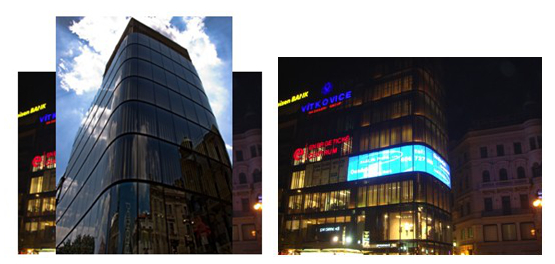
The engineering case, left: appearance, screen does not light when the building
right: the display screen is bright
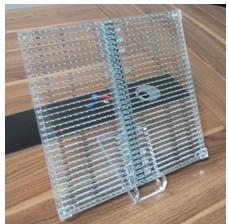
The LED display technology design has greatly reduced the obstacles to our sight from the structural components, and has improved the perspective effect to the maximum. At the same time the display effect is novel and unique, and the painting seems to be suspended on the glass curtain wall when the audiences stand in the ideal range. To advertise in this kind of screen, the unnecessary background can be transformed into the black when designing the content pictures of advertisements, only to display what need to be expressed. When playing, the black part does not light, which is a transparent effect. This kind of playing method can greatly reduce light pollution, meanwhile it can reduce energy consumption and over 30% energy saving can be realized than ordinary LED screen.
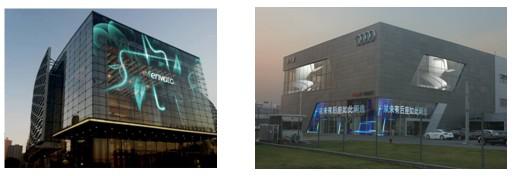
Advantages and characteristics of Shenzhen Verypixel New ultra transparent LED display equipment
a. It has a very high perspective rate, which has guaranteed the lighting demands and viewing angle range of lighting structures like floors, windows, glass facade, and guaranteed the original perspective function of glass curtain walls.
b. It occupies little space. The thickness of its motherboard is only 10mm, and the weight of the display screen body is only 12Kg/ square meters. The architectural structure needn’t to be changed, and it can be directly sticked onto the glass curtain walls.
c. It don’t need steel structure, which can save the cost for installation and maintenance largely. It is installed and maintained indoors, which is very simple.
d. Its display effect is unique. Because the display background is transparent, the advertisement picture seems to be suspended on a glass curtain wall, which has very good advertising effect and artistic effect.
Project example: In 2012, a large water curtain light stage, of which the screen is a glass one, needs to be created around a newly-built square in Huaqing Hot Spring tourism in lintong, Xi’an. Under the square is a large shopping mall. The LED screen is installed on the sloped glass curtain wall around the square, which plays video images in the evening as the background of the stage, and the glass needs to be transparent during the daytime, so the LED screen is required to be transparent. New ultra transparent LED display technology successfully meet the requirements of the project, and very shocking spot effects have been received combined with a series of technology like the spot water curtain and acoustics.
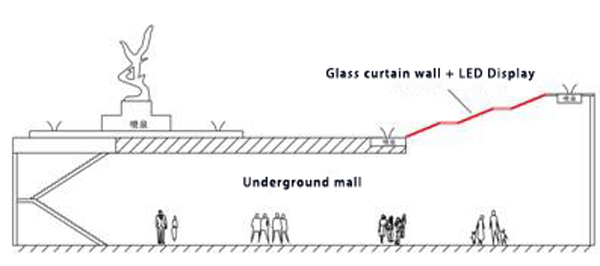
Schematic diagram of the Huaqing Hot Spring square design

Under the square’s glass curtain wall is a large shopping mall

The night is a grand central stage
D. The market appliance potential
We think that the new ultra transparent LED display screen has developed a new application field, and it has a broad market prospect, especially suitable for the field of "building media". It caters for demands in a newborn market, and has created a kind of high-quality outdoor media resource successfully.